Now & New
G7-Postponed Flower Festival: More Fun in Fewer Days
Every 3rd, 4th, and 5th of May since 1977 (with the exception of 2020), the Flower Festival had been held in hopes that we, the people of Earth, can inch ever closer to world peace. Despite 2023 being the year Japan fully rebounded from the pandemic, Hiroshima City was shaken up by the G7 Summit held in mid-May, and the days leading up to said summit kept us locals on our toes. Cops from all 47 prefectures convened in our city to patrol and barricade the streets of downtown, and during the summit, I didn’t step out, period. In the end, the necessary preparations for the summit caused the Flower Festival to be postponed to the 10th and 11th of June, the weekend after Toukasan.
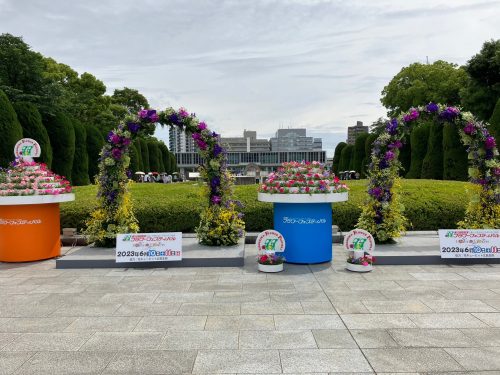
Yes, you read that right; this year’s Flower Festival only spanned two days instead of the usual three, but in retrospect, that wasn’t much of a disappointment. Having the Flower Festival in a different month meant different flowers in season for us to admire, and despite the event taking place during the rainy season, fortunately, the skies were dry for that weekend. Much as I loathed May for the stress the G7 Summit caused so many of us Hiroshimarians, one thing we can be thankful for was that it made June more eventful than it usually would be, and an extra festival to fill my weekend is hardly worth a complaint.
The Show Must Go On
The Flower Festival is usually filled to the brim with shows on multiple stages scattered throughout the city, and this year, they had stages far and wide. In addition, there is always a special guest invited to Hiroshima to kick off the entertainment on the centrally-located Carnation Stage. In 2023, that guest was Hiroshima native and star singer Hitomi Shimatani, who last had the honor in 2003. Ms. Shimatani is originally from an island called Kurahashijima, which belongs to the city of Kure, but since becoming famous, she has been living in Tokyo and took a Shinkansen down here to perform on the morning of the 10th of June.
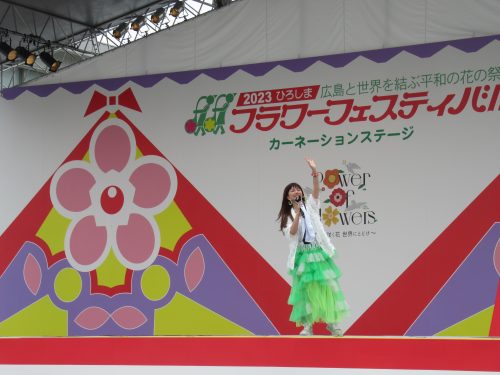
Security was tight that weekend, with a helicopter constantly commanding the skies to ensure no one was up to funny business. There was also a strict policy against photographing or recording videos of big celebrities like Hitomi Shimatani or STU48; Ms. Shimatani personally gave the green light while she was on stage, or else you wouldn’t have seen the above photo. She was elated to announce her return to the music scene by singing her newest piece, “Re:START!” and also to let us know about Peace Stock, an upcoming music festival at the Marina Hop scheduled for November 12th, where she will appear once again.
The Carnation Stage also saw some international performers putting on exotic shows like Mexican mariachi, Brazilian samba, traditional Korean dance, and Chinese Bian Lian (shown above) over the course of the festival’s two days. I wish I could’ve stuck around to see all of them, but since I had other spectacles to catch, I was only able to watch the Bian Lian, and I’m glad I did! For those who don’t know, Bian Lian is an ancient art used in Chinese opera wherein actors change masks in the blink of an eye through seemingly minute and momentary motions such as a wave of a fan or turning of the head. This performer was a man from Sichuan Province in Southwest China, and during his show, he approached the audience to throw Chinese decorative knots (中國結 – Zhōngguó jié in Mandarin, Chūgoku musubi in Japanese) into the crowd to symbolically tighten the bonds between the two nations. After the show, when he was being interviewed and asked about how he changed faces so rapidly, he replied that it was a “Chinese state secret,” a cheeky twist on magicians safeguarding their trademark techniques.
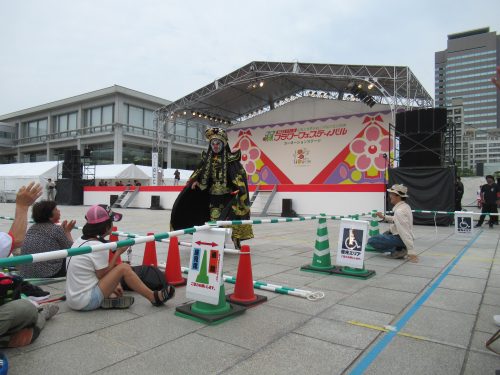
Moment of Joy: 20-Year Gap
Out of all the shows I saw that day, I was definitely most ecstatic to see Hitomi Shimatani as I had known about her ever since my teenage years when her song “Angelus” appeared in the anime Inuyasha and the video game Dance Dance Revolution SuperNova 2. When I first arrived at the Carnation Stage and found out that photography and filming were verboten, I thought the performance would be rather impersonal like any other concert.
However, I found Ms. Shimatani to be incredibly down-to-earth as she recounted how grateful she was to be invited back to the Flower Festival after 20 years, and hoped to be invited again in another 20 years when she becomes an old lady. In order for all of us to enthusiastically await that prospective moment, she unilaterally granted permission for the audience to whip out their cameras for her last song, and that alone made the festival for me.
Dancing in the Street
In between all the performances on the Carnation Stage, people were flowing through Peace Memorial Park like river sediment, but every grain hovered to photograph the flower pyramid before continuing downstream. There were so many angles from which the object could be photographed, but the point was to capture the flame atop the structure, so I walked around the pyramid several times before finding an appropriate background for the blaze. Photographing it from afar is also more recommended than getting up close to it like so many people did, and not having the complete structure in the picture.
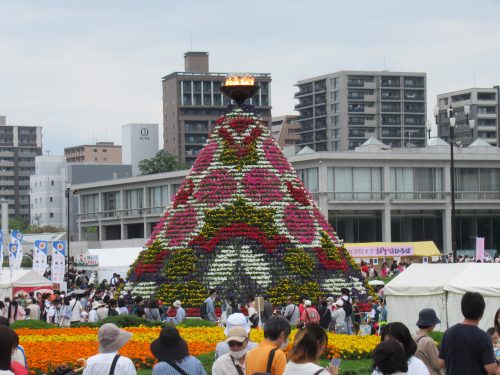
The early afternoon (before the Bian Lian show) also saw a parade of flower-laden floats going down Peace Boulevard, in which designated ladies in suits promoting the festival and Hiroshima Prefecture made an appearance and waved to the onlookers on either side. They went by slowly so the festival goers could savor the moment, as the floats themselves were just as photogenic as the pyramid. Crowds of folks gathered on both side of the street not only for this procession, but also for the upcoming yosakoi parade, which was the event I was waiting for.
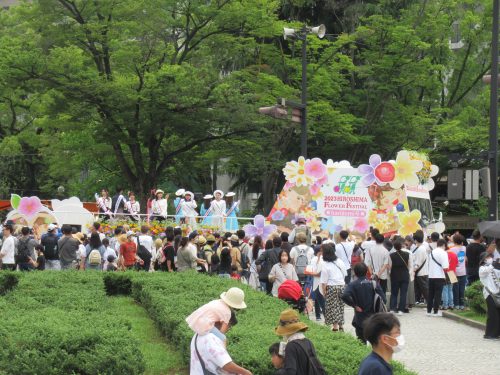
The yosakoi parade is an integral part of the Flower Festival, and since it gets pretty long, it’s broken into segments by group, each of which follows a festival float. Since there were more groups dancing than there were floats to go around, the floats rotated when the group reached the Motoyasu River and dispersed. All the while, pedestrian crossings were inhibited to allow the dancers to proceed unobstructed, so I chose my viewing spot carefully before the guards blocked the crosswalks.
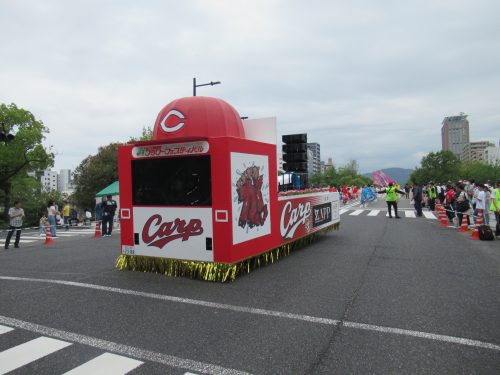
The groups participating in the yosakoi parade hailed from a variety of different organizations, from dedicated yosakoi troupes to college dance clubs and even local daycare centers. Everyone wore flashy, coordinated costumes, though dancers from the actual troupes definitely won in the cool factor department. The performers below had uniforms I immediately recognized from last year’s Flower Festival and Fukuyama Rose Festival, and were brimming with energy as usual.
The music used in the dance routines also varied, but was dominated by the yosakoi genre, a modern take on traditional Japanese music from Kochi Prefecture. However, another song that often blared was “Hanaguruma,” which is the theme song of the Flower Festival and the tune played over the loudspeaker citywide at 18:00 every evening. With remixes of the two aforementioned songs and other pieces added at the discretion of each team, every group in the parade brought something unique and pleasing to the eye and ear.
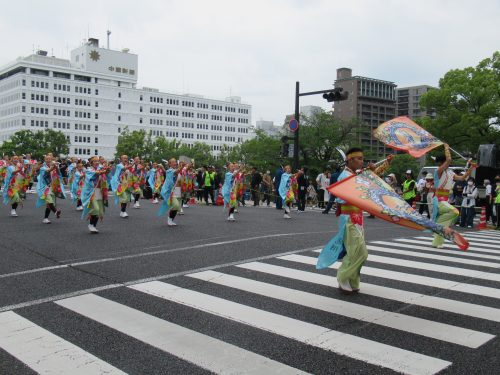
Stands That Stand Out
When I had my fill of the parade, I had the desire to fill up my belly with some festive and portable grub. Almost every stand I saw on Peace Boulevard that weekend was the same as what I had seen during Toukasan, yet I was still enticed by the endless options: hashimaki (something like okonomiyaki on a stick), chilled cucumbers, shaved ice, candied fruit, and that ¥10 coin bread that I’ve grown fond of. As far as cost performance and portability are concerned, I believe the character-shaped baby castella are among the best foods to grab to go, plus the decorative character bags serve as collector items in their own right. Ultimately, I went for something I had never seen at any Japanese festival: scallion pancakes, yet another item on the list of recent Taiwanese food fads. These were made to order with a small selection of fillings to choose from; I kept it simple and went for egg and cheese (though I prefer to have them plain).
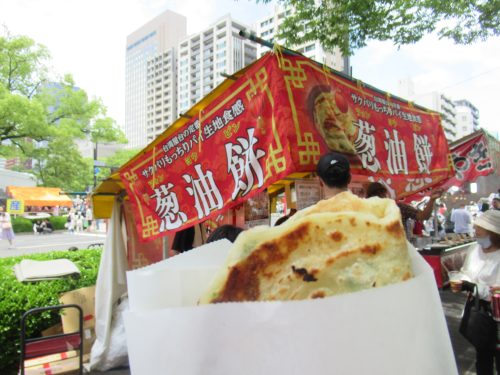
Outside of food, there were once again stands with carnival games of skill and chance, vendors selling character masks just like during Toukasan, and miscellaneous tents promoting certain businesses or international travel destinations like Honolulu, Hannover, and Guadalajara. These multicultural stations had hands-on creative activities for kids and families, but sadly, I was occupied by the shows and foraging for food so I had to skip out on said experiences. One stand that stood out to me was advertising an equestrian club in Higashihiroshima, and even brought a real pony to their tent on the 11th to appeal to visitors. No one was allowed to ride it, but watching it graze peacefully inside its enclosure was good enough for me.

Emphasis on Flowers
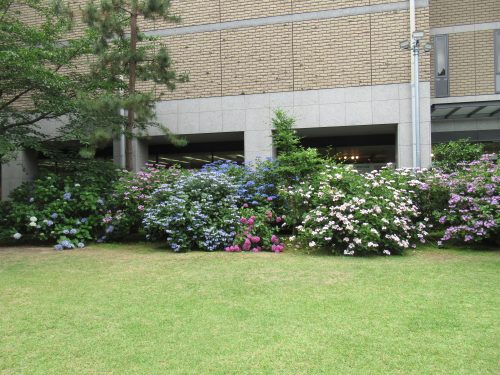
Peace Boulevard becomes a warzone every Flower Festival, and between the sweltering sun and the cramming of people in close quarters, it’s easy to get disoriented and even suffer from heatstroke (there was always someone occupying the medical tent). One may be tempted to take a break from the action of that weekend and go see some flowers without the festival part, which can be done at Shukkeien. As June is hydrangea season, I jumped at the chance to see hydrangea during the Flower Festival, as they normally couldn’t be seen when the festival takes place over Golden Week. The bulk of these puffy beauties could be found in the plaza adjacent to the Prefectural Museum of Art, and because there were so many visitors posing for photos in the area, it took quite a while for me to take a serene photo like the one above.
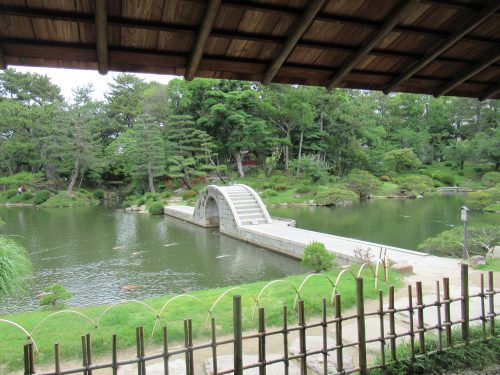
In addition, Sunday, the 11th of June, was also the date of the Taue Tea Ceremony being held inside the garden’s Seifukan teahouse. Anybody who buys an admission ticket to Shukkeien and shows up to the registration tent early enough can attend one of the several tea ceremonies that day for an additional fee. Photos of the interior of Seifukan are not allowed, but we had this gorgeous view of the stone bridge arching over the pond inhabited with carp. I hurriedly snapped this landscape before sitting down to indulge in green tea and Japanese sweets. There were frequent interruptions from the helicopter above, but I found those to be amusing and enjoyed the ceremony in spite of the added ruckus. Before leaving and heading back to the chaos that was the Flower Festival, I took a photo of the ceramic trays on the display in the entryway; each participant got to eat his or her snacks off one of those trays and take it home as a souvenir.
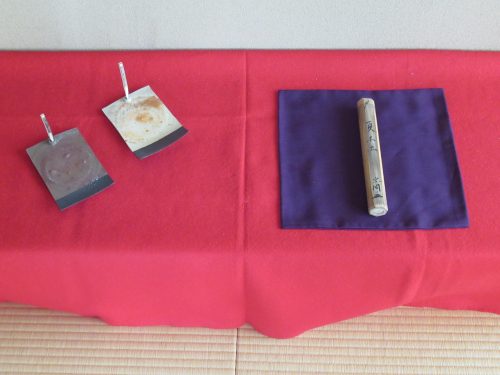
Indeed, the Flower Festival may have been reduced to two-thirds of its original length and delayed by over five weeks, but the change in pace and environment ironically increased the amount of fun I had that weekend. On top of getting to see some lovely hydrangea during the Flower Festival, having an extra festival in June helps to make up for the lack of public holidays that month. It was also a blessing not to have it rain a single day of the festival, though in recent years, the rainy season has been starting later and later so festivals in late June and early July are projected to be kind of iffy. All we locals can do is hope that the timing of said torrents won’t align with too many celebrations for the rest of the summer. The G7 Summit last month put Hiroshima on the radars of international tourists much more than ever before, so the more visitors frequent festivals in a sunny and flowery Hiroshima, the merrier we’ll all be.

Written by the Joy in Hiroshima Team
